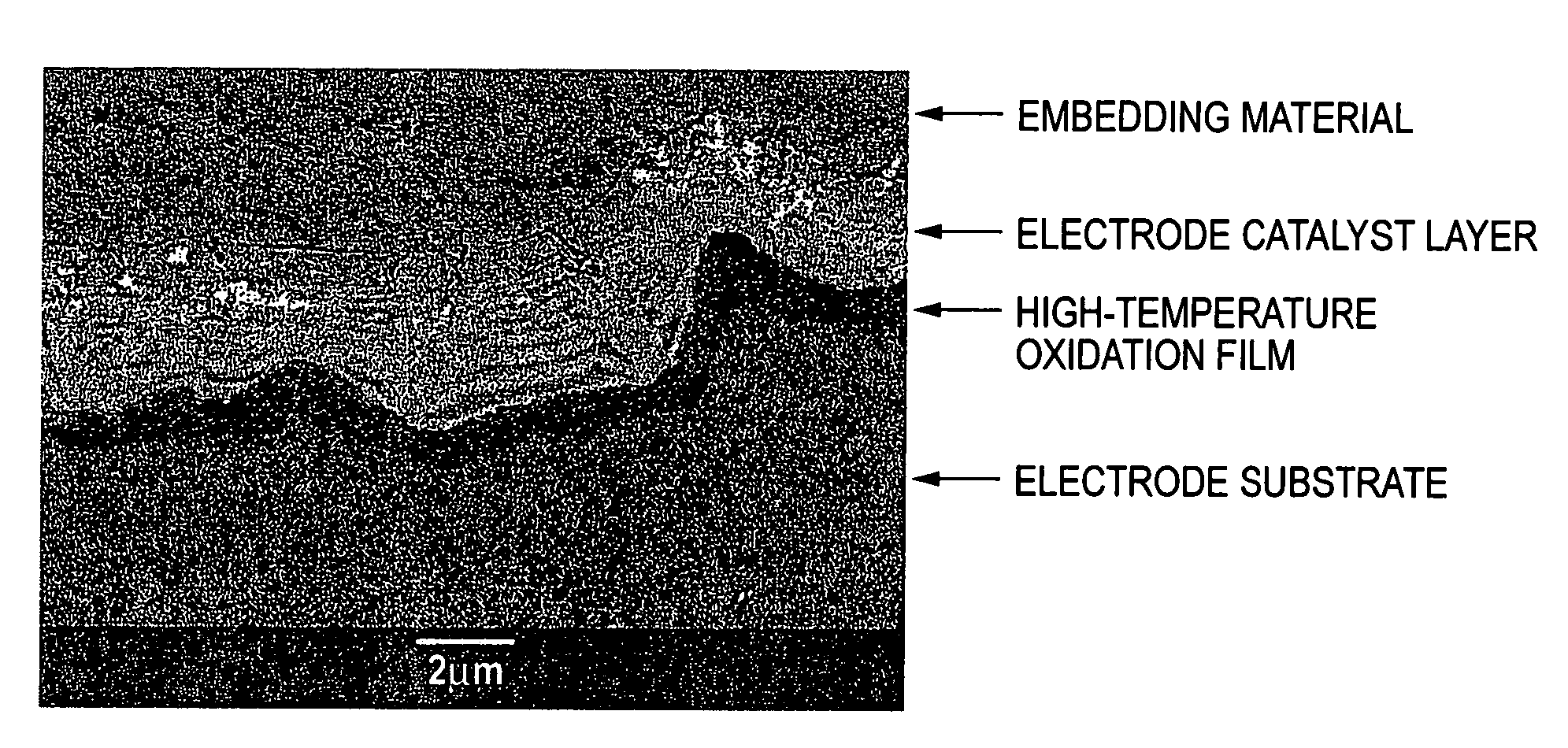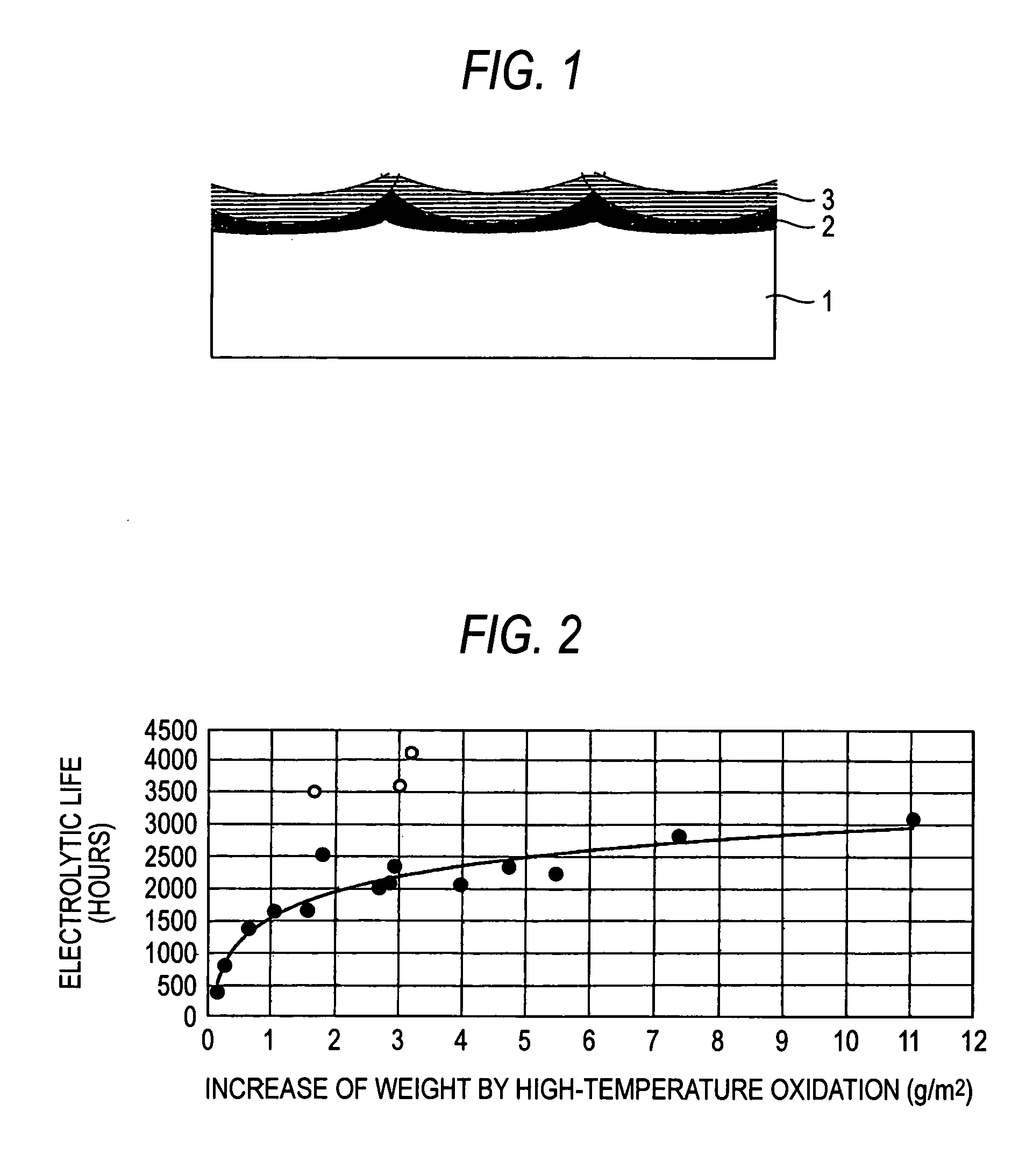Electrolytic electrode and process of producing the same
a technology of electrolytic electrodes and electrodes, applied in the direction of electrolytic coatings, liquid/solution decomposition chemical coatings, manufacturing tools, etc., can solve the problems of increasing electrode potential, impurities likely to accelerate the consumption of electrode catalysts, and extensive management of electrolytic baths, so as to increase the weight of high-temperature oxidation films. , the effect of increasing the weigh
- Summary
- Abstract
- Description
- Claims
- Application Information
AI Technical Summary
Benefits of technology
Problems solved by technology
Method used
Image
Examples
referential example
[0074]To avoid abrasion or dropping of the oxidation film due to strong contact or generation of an error due to partial contact, mercury was used as a contact material.
[0075]First of all, mercury was poured into a nickel-made cylindrical container having an inner diameter of 20 mm and a depth of 20 mm. A metallic titanium rod having a diameter of 3 mm and a length of 100 mm was subjected to high-temperature oxidation treatment at a prescribed temperature for a prescribed period of time, one end of which was then cut to peel away a high-temperature oxidation film so as to make it possible to flow a current. The titanium rod was semi-fixed, and one end where the high-temperature oxidation film remained was immersed in mercury in a length of about 9.9 mm such that the contact area became about 100 mm2 (1 cm2). A prescribed value of a current was flown while setting the titanium rod side as plus and the nickel container side as minus, and a voltage between the titanium rod and the nick...
example 1
[0080]The surface of each of 15 sheets in total of 3 mm-thick titanium plates for general industrial use was roughed by blasting with #20 alumina particles and then cleaned by dipping in boiling 20% hydrochloric acid to prepare 15 sheets in total of electrode substrates. The substrate was subjected to temperature rising in air at a rate of about 5° C. / min from room temperature. The substrate was heat treated at each of the arrival temperatures for a prescribed holding time (see Table 2) and then subjected to furnace cooling to obtain a high-temperature oxidation film of titanium substrate. An increase of weight of the high-temperature oxidation film of each substrate (g / m2 and a value as reduced into mg / cm2) is shown in Table 2 (Examples 1-1 to 1-15).
[0081]A 10% hydrochloric acid mixed solution of iridium chloride containing 70 g / l of iridium and tantalum chloride containing 30 g / l of tantalum was coated on each titanium substrate having such a high-temperature oxidation film formed...
example 2
[0099]The surface of each of 8 sheets in total of 3 mm-thick titanium plates for general industrial use was roughed by blasting with #20 alumina particles and then cleaned by dipping in boiling 20% hydrochloric acid to prepare electrode substrates (Examples 2-1 to 2-8).
[0100]First of all, prior to forming a high-temperature oxidation film of substrate, each of the six sheets of electrode substrates of Examples 2-1 to 2-6 was coated once with a 10% hydrochloric acid solution of tantalum chloride TaCl5 containing 10 g / l of tantalum as a coating solution for forming a high-temperature oxidation film described in Example 1 of JP-B-60-21232. After drying, the resulting substrate was subjected to temperature rising in air at a rate of about 5° C. / min from room temperature, heat treated under a prescribed condition shown in Table 3, and then subjected to furnace cooling, to obtain a high-temperature oxidation film on the titanium substrate.
[0101]From the analysis of the X-ray diffraction o...
PUM
| Property | Measurement | Unit |
|---|---|---|
| temperature | aaaaa | aaaaa |
| thickness | aaaaa | aaaaa |
| temperature | aaaaa | aaaaa |
Abstract
Description
Claims
Application Information
 Login to View More
Login to View More - R&D
- Intellectual Property
- Life Sciences
- Materials
- Tech Scout
- Unparalleled Data Quality
- Higher Quality Content
- 60% Fewer Hallucinations
Browse by: Latest US Patents, China's latest patents, Technical Efficacy Thesaurus, Application Domain, Technology Topic, Popular Technical Reports.
© 2025 PatSnap. All rights reserved.Legal|Privacy policy|Modern Slavery Act Transparency Statement|Sitemap|About US| Contact US: help@patsnap.com



